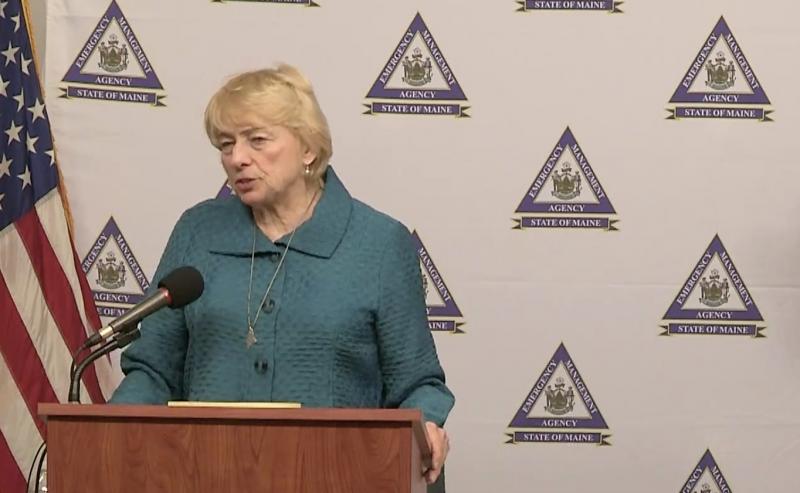As states fight COVID-19, revealing partisan responses, Maine takes protective action
On April 2, Gov. Janet Mills put a Maine stay-at-home order into effect, joining in the third wave of states issuing those orders to limit the spread of COVID-19.
States began acting when New Jersey made the order on March 21. The states sought to keep ahead of the spread, after trying to avoid limiting the freedom of movement valued by most people as a right.
Mills’ order recognized the right of each state to protect public health and safety within its borders, especially needed in the absence of a coordinated national response to a worldwide crisis.
COVID-19, the illness caused by a new coronavirus, began in Wuhan, a city in China unknown to most Americans. Yet, in less than three months it spread to Maine.
Still, American policy treated the virus as if it recognized borders. By the time President Trump declared a national emergency a few days ago, five states had still not ordered people to stay home and three more had only limited restrictions.
Much attention has been focused on determining when the U.S. knew action was needed and began preparing for the invasion of the virus. Whatever the answer, it’s evident that much of the initiative was left to the states.
There is no medication known to reverse COVID-19 and no vaccine. On the front lines, states needed to acquire equipment to deal with caring for those who took ill and order changes in human activity that would limit the spread of the virus.
Some did better than others. Washington, the first state to be hit hard, was in the first wave of states to issue stay-at-home orders. It was joined by Oregon and California, covering the entire West Coast. It may have paid off. Los Angeles has experienced a lower-per-capita impact than Boston.
The problem in leaving the battle against the worldwide spread of a virus to the states was the shortage of equipment needed to fight it: masks, personal protective gear, tests and ventilators. Inevitably that meant states would compete to obtain supplies they needed. Competition was not the best way to allocate scarce resources nationally.
Also, if governors had spare equipment, how likely would they be to send it out of state when they might need it later? Some sharing took place but it was politically risky.
The states had expected that a federal backup existed and could be deployed as needed. Instead the stockpile was both inadequate and kept in federal hands. The federal government competed with states in seeking supplies from private manufacturers.
The response in states was uneven, despite the threat being national. Mills has issued clear directives. Maine data has been provided daily, though it has fallen short in some details that other states publish. Maine CDC, the source, doesn’t appear politically influenced. It’s probably not possible to collect hard data on compliance.
One characteristic of state responses stands out. States with Democratic governors were the most active in responding early while most GOP governors hung back.
In the first wave of nine state stay-at-home orders, only one governor was a Republican. Mike DeWine of Ohio took the threat seriously, listened to his science advisors and was criticized by fellow Republicans. One leader reported that his “friends” find that DeWine is “overreaching and ruining the economy.”
Like Mills, the states that have taken the most organized action against the virus are relying on the advice of scientists who serve no matter what party is in power. All of the lagging states have Republican governors seeking to support Trump’s attempts to minimize the threat and “reopen” the economy by accepting some casualties.
The split among states is clear evidence of how the response to COVID-19 has been politically partisan. Trump supporters claim that shutting down parts of the economy is more harmful than the virus itself. Opponents, including all Democratic leaders, focus more on health than economic activity.
Now, three states on the West Coast, called the Western States Pact, and seven states in the East, including New York, are working on joint plans for recovery. All are headed by governors who reject Trump’s claim to call all the shots. Some states, going it alone, try to track Trump’s policies.
Trump attacks states and governors. He assigns them much of the blame for an insufficient response. If the economy only can open slowly, governors face charges of foot-dragging and inadequate loyalty to the president.
States may not forget their experience in this crisis. When it has passed, the federal-state relationship could be changed for good.
Gordon L. Weil has been active in politics, journalism, publishing and energy consulting. A graduate of Bowdoin College, he has a master’s degree from the College of Europe (Belgium), and a Ph.D. from Columbia. He is an Army veteran.
He was a top aide to U.S. Sen. George McGovern during his run for president. In Maine, he served as Commissioner of Business Regulation, Director of the Office of Energy Resources and the state’s first Public Advocate. He was a Harpswell selectman. He led the negotiations that created the unified New England power grid and chaired the national organization of state energy agencies.
He reported for the Washington Post, Newsweek, London’s Financial Times, the Wall Street Journal and WNET (New York). His weekly commentary has appeared in Maine newspapers since 2008. He has written or edited 16 books or collections ranging from the biography of Sears, Roebuck to the three-volume U.S. Supreme Court original jurisdiction decisions. His company, sold in 2005, was the largest publisher of state government regulatory codes.
Event Date
Address
United States
























